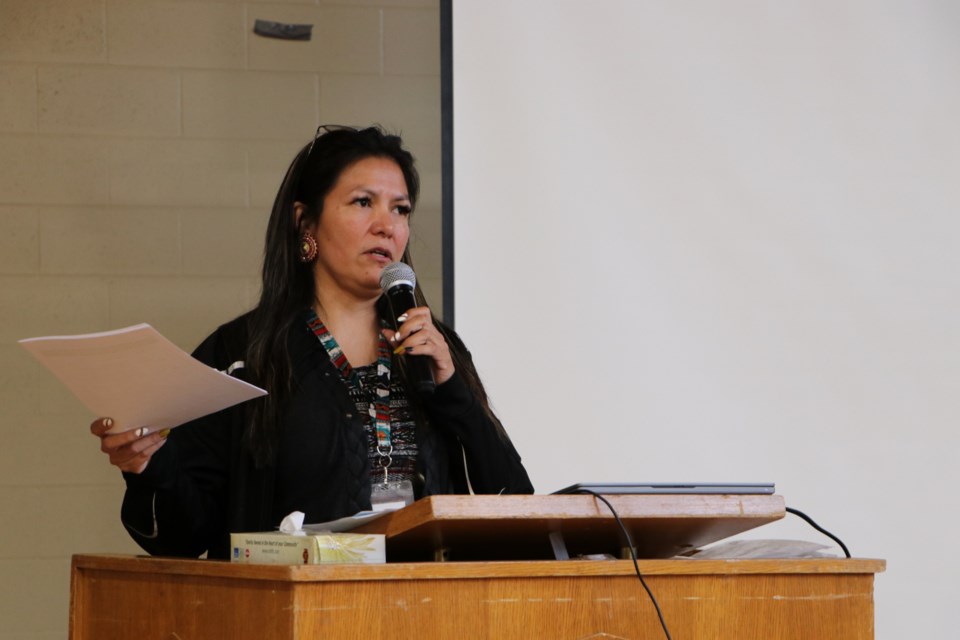Mînî Thnî, Alta — Since the claims period for the First Nations Drinking Water Settlement opened about three months ago, Stoney Health Services has distributed over 200 forms to individuals and families considering seeking reparations for years of neglect by the federal government to provide access to clean, safe drinking water.
In the last two decades, Stoney Nakoda First Nation has been under a drinking water advisory for about half that time. According to Stoney Health Services (SHS), unclean water advisories were in place from Nov. 27, 2001 to Aug. 2, 2005 and again from Oct. 20, 2006 to March 21, 2014.
Stoney Nakoda First Nation and the people who lived within its reserve borders, under the three bands of Chiniki, Bearspaw and Wesley/Goodstoney, and those who were subject to a drinking water advisory that lasted at least one year between Nov. 20, 1995 and June 20, 2021 are eligible to make a claim under the settlement agreement.
At an SHS info session about the settlement in Morley on May 25, many community members complained of experiencing skin irritation, stomach problems, and other ailments from using their tap water – and not just within the advisory time frames.
“Most people who talk about their water [say] it’s either brown, yellow, or just not good,” said SHS Mînî Thnî Crisis Support social worker and Indigenous liaison Myrna Teegee, who was hosting the event on behalf of the health authority. “A lot of people have mentioned they have eczema, believed to be from their water.”
Most won’t consume their water straight from the tap, she added, even when there isn’t a water advisory. People will instead opt to boil it first, buy it from the store, or source it from a mountain spring – where it’s deemed safer to drink.
Olivia Wesley, a resident of Morley, said at the info session that she’s experienced both an upset stomach and skin irritation from using the water.
“For me personally, it can irritate my skin when I bathe in it,” she said. “And then my stomach has a hard time tolerating it if I drink it.
“It’s really damaged our health and wellbeing. Water is very important to us. Water is life. How can we live without water?”
Wesley said she plans to make a claim, but she isn’t convinced the settlement would be enough to repair the damage done by the federal government to First Nations across the country for years of inaction to fix or provide infrastructure for access to clean drinking water.
“I do want to make a claim, but not only for the money,” she said. “I want to know if this problem is going to be fixed or if we’re going to live like this forever with the government throwing money at us.
“Health ... you cannot claim it.”
The settlement, which was agreed on after a years-long battle between First Nations and the federal government, includes $1.5 billion for people deprived of clean drinking water, $6 billion to upgrade water infrastructure, and $400 million for the First Nation Economic and Cultural Restoration Fund.
Those who have experienced further harm from serious injuries or illnesses may be eligible for additional compensation, according to the 20-page individual claim form. The list of harms specified includes ailments like digestive, respiratory, dermatological, liver, neurological, kidney and mental health issues. It also includes cancers and tumours.
Teegee and two other social workers at SHS have been assisting applicants by printing off forms and answering questions since the claims period opened March 7. The idea of hosting the info session was to address as many questions as possible in a communal setting.
In the days following the session, Teegee reported receiving more voicemails and texts to answer from people than before. She says SHS will continue to be there to answer questions and assist anyone seeking reparations until the settlement closes to applications.
The claim period ends March 7, 2023. For more information, visit firstnationsdrinkingwater.ca.



